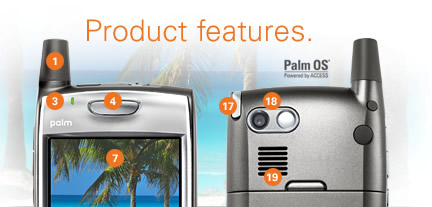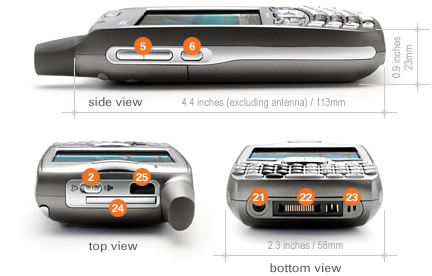Palm Treo 700p
2. Features
Phone Features/Function:
Depending on your lingo or what you read, the Treo is a "Smartphone" with a touch screen - for many people that means it is a "phone" first. As a phone, there are several important areas of importance to look at.

Call Quality:
I found the call quality on the 700p to be a notch above the 650. Volume in the headset was certainly loud enough. When used as a speakerphone, however, the tiny speaker started distorting at higher volumes. This didn't affect my ability to hear the caller it was just not "crystal clear."
Placing calls is straightforward and easy. Hit the "phone" button and either dial numbers or navigate (using the d-pad) to stored favorite buttons. These buttons are easy to set up - just like on the 650. There is not the delay that many experienced on the 650. Calls go through very quickly and sounded very clean through the Treo itself and also through the Bluetooth devices I tested.
When a call comes in, a picture of the user (if you have stored the contact with a picture) along with the caller ID shows up on the screen. You now have the option of answering, ignoring (sending to voicemail) or responding immediately with an SMS message instead. This is particularly useful if you are in a situation where you cannot talk- but you need to respond to the call.
All calls are stored in your call log for easy retrieval at a later time.
The phone integrates effortlessly with the contacts that you HotSynced from your PC. The treo 700p can Sync with either the included Palm Desktop App or with Outlook.
The Top of the Phone screen shows you your battery life, signal strength (an extra bar has been added,) whether Bluetooth is enabled and active, and the GPS locator icon.

Bluetooth:
 The
Treo 700p ships with Bluetooth 1.2, an incremental improvement over 1.1 which
was standard on the 650. I paired the 700p with various Headsets and Carkits
with no trouble. The Bluetooth connection held for upwards of 20-25 feet away
from the phone and call quality was as good or better than using the same headset
on the 650.
The
Treo 700p ships with Bluetooth 1.2, an incremental improvement over 1.1 which
was standard on the 650. I paired the 700p with various Headsets and Carkits
with no trouble. The Bluetooth connection held for upwards of 20-25 feet away
from the phone and call quality was as good or better than using the same headset
on the 650.
Bluetooth peripherals, like GPS devices, were also easy to connect and use. I was also able to "Pair" my 700p with my computer and use Bluetooth to send and receive files as well as perform a Bluetooth Hotsync with the device. The pro side is that it is quick and cool - the con is that it is much slower than using the included USB cable.
The buzz on Bluetooth 1.2 is that it supports a true "Hands Free" protocol. Most Bluetooth 1.2 phones can use voice tags and voice dialing from a Bluetooth headset. We all know that this wasn't possible with the 650. Sadly, according to my own usage and what I have read, this version of the Treo is NO better in this regard. What a disappointment. Now, I will say that if your Car kit has the ability to have its own voice tags - they will then dial the Treo via Bluetooth. I hope that Palm will somehow fix this in the first of what will be many updates (according to past history) for the 700p.
Camera Features:
The 700p ships with a 1.3 megapixel camera – a huge improvement over the old VGA camera. Pictures were sharp and clear. From the camera screen you can easily navigate to your library, or activate the Video recorder. There is a 1x and 2x zoom feature on the camera but no flash is included. There is a self portrait mirror on the back. You can easily store or view your images on an SD card (not included) or in the main memory of the Treo.
One of the great features of an integrated device is the ability to easily email the pictures you take. I was able to use this feature effortlessly as I was on the 650.
The included video recorder was somewhat of a disappointment - as are most vide recorders on cell phones. The resolution is supposed to be 352-by-288 videos at 13 FPS but is sure didn't look that way in real life.
Email:
 Certainly
one of the draws to a converged device is the ability to quickly get email
and access the web. The included VersaMail POP3/IMAP mail client now is able
to sync e-mail and contacts with Microsoft Exchange 2003 servers. VersaMail
also now remembers recently used addresses, and automatically opens
DocumentsToGo for attachments. The 700p includes a link to Good's
GoodLink corporate e-mail system and Sprint's own Business Connection e-mail.
Both of these can be configure for "Push" email technology which
makes the Treo act very much like a "BlackBerry."
Certainly
one of the draws to a converged device is the ability to quickly get email
and access the web. The included VersaMail POP3/IMAP mail client now is able
to sync e-mail and contacts with Microsoft Exchange 2003 servers. VersaMail
also now remembers recently used addresses, and automatically opens
DocumentsToGo for attachments. The 700p includes a link to Good's
GoodLink corporate e-mail system and Sprint's own Business Connection e-mail.
Both of these can be configure for "Push" email technology which
makes the Treo act very much like a "BlackBerry."
I found it very easy to configure each of my four email accounts - a mixture
of both POP and IMAP accounts.
Messaging:
The separate SMS/MMS app was a joy to use with the QWERTY keyboard. You can easily send text messages and attach media of all sorts. You can also have a threaded, conversation-based view, where your "back and forth" texts with one user appear like an IM conversation.
The Treo can easily configure separate tones for messaging so it is clear when you have a text as opposed to an appointment or a voice mail.
Web:
The Treo 700p is the first Treo to take advantage of Sprint’s Power Vision Network.
The Good:
 PowereVision
is extremely fast (if you are in a PowerVision coverage zone.) I live on an
Island near Boston - while I can sometimes get the full advantage of the Power
Vision network on my Samsung MM920 - I had less luck with the Treo 700p.
When I did get it, it was very, very fast. The PowerVision Network
allows the user to access Sprint TV, Sirius Radio, lots of media content, streaming
video and other goodies.
PowereVision
is extremely fast (if you are in a PowerVision coverage zone.) I live on an
Island near Boston - while I can sometimes get the full advantage of the Power
Vision network on my Samsung MM920 - I had less luck with the Treo 700p.
When I did get it, it was very, very fast. The PowerVision Network
allows the user to access Sprint TV, Sirius Radio, lots of media content, streaming
video and other goodies.
Web browsing was faster on the 700p than the 650. The standard Blazer browser has been updated and streaming media is now handled with a bundled Kinoma media player.
The Bad:
More often than not, I was not able to access the Power Vision Network and utilize its full capabilities. Also, even when at full speed, streaming video was choppy and a much lower resolution than home recorded video.
Music and Streaming Video:
Music is handled this time around with a bundled, stripped down verson of Pocket Tunes. This was welcome news to me since I wasn't a fan of the Real Player on the 650. This version of Pocket Tunes is fine for very rudimentary tasks, music playback (MP3) and playlist organization. If you want to do any of the following you will need to pay $25.00 to upgrade to Pocket Tunes Deluxe:
Online Music Store Support |
Access millions of tracks from compatible online music stores* |
Internet Radio |
Listen to internet radio stations on your Palm® Treo 700p |
WMA File Support |
Fit more music on your Palm® Treo 700p with smaller WMA files |
Bookmarks |
Never lose your place again in your audio books or music |
Auto-Bookmarks |
Automatically create bookmarks |
Crossfade |
Smoothly fade from one song to the next |
Gapless Playback |
No skipping between songs recorded from live albums or DJ mix CDs |
Play Ogg Vorbis and WAV Files |
Play Ogg Vorbis and uncompressed WAV files |
Hi-Fi Graphic Equalizer |
Optimize your listening experience |
Bass Boost |
Crank up the bass to enjoy your tunes |
So, most of the fun stuff you might want to do with the music player are not included in the "basic" version.
Streaming Video is possible from compatible web sites through a bundled version of Kinoma's media player. Video streams were a bit choppier than on other PowerVision phones I have tested. But, it was still very cool to watch ESPN on my Treo.
PowerVision on the 700p was a mixed bag.



















